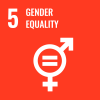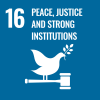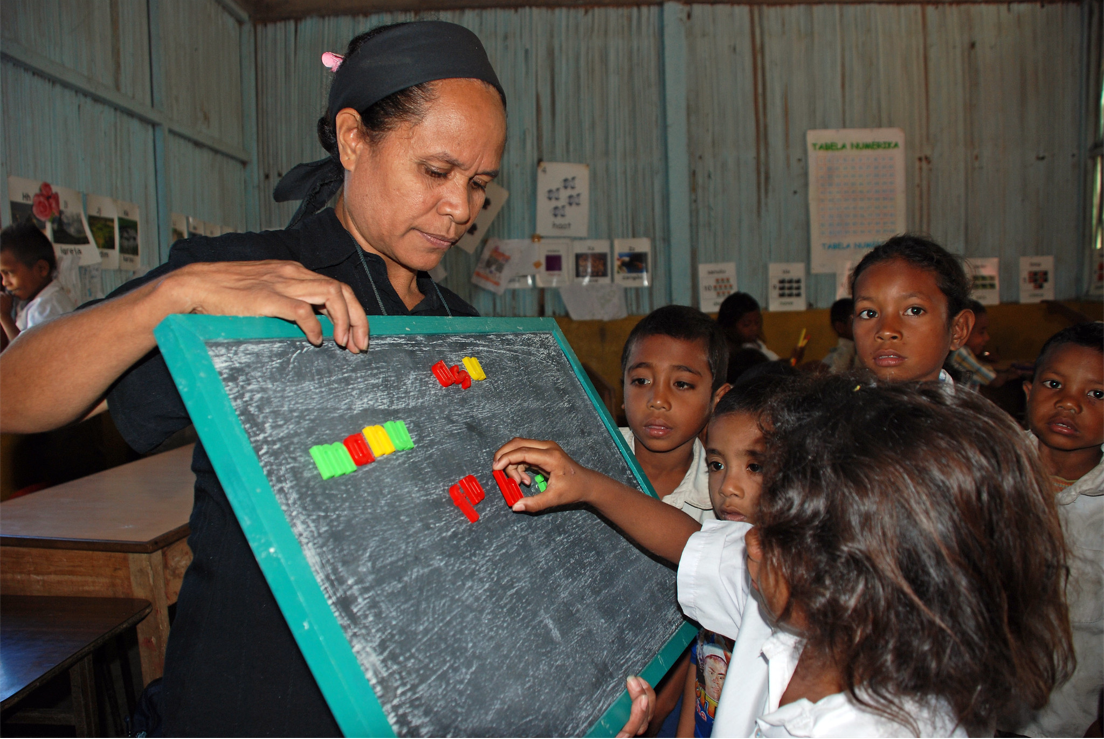
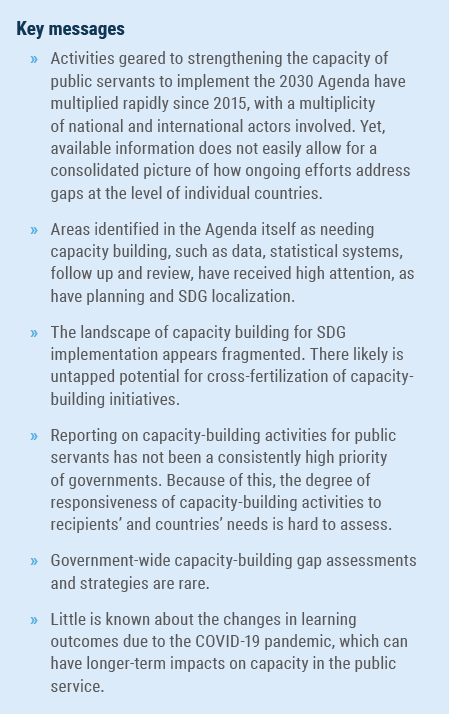 Introduction
Introduction
The 2030 Agenda recognizes that capacity in governments at all levels is critical to steer and support the transformations which it calls for. Thus, public servants at all levels of government need the capacity to successfully implement, follow up and review the Sustainable Development Goals (SDGs). The SDGs are an umbrella framework encompassing almost every sector of human activity. In a broad sense, “capacity for implementing the SDGs” entails the capacities necessary to implement all the SDG targets. Capacity- building efforts at the level of specific goals and targets, although important, are not the focus of this brief. Instead, the brief focuses on capacity-building actions for cross-cutting functions that directly support SDG implementation, monitoring, and evaluation. The term “capacity-building” covers a hierarchy of needs, from institutional structures, systems and roles, to staff and infrastructure, to individual skills, and tools. All these levels, as well as the broader institutional and cultural contexts, need to be considered for capacity-building actions to be effective. The brief explores the landscape of capacity-building activities targeting civil servants based on publicly available information for a sample of 24 United Nations Member States.
Actors involved in capacity-building for SDG implementation in the public sector
An impressive variety of actors, both national and international, enhance national public servants’ capacities for SDG implementation. Government departments have developed training material and led training activities on SDGs for members of the executive. In Indonesia, for example, the Ministry of National Development Planning (with support from the United Nations Development Programme Country Office in Indonesia and the Tanoto Foundation) has set up a learning platform for government officials titled “SDG Academy Indonesia”. Likewise, training is offered to members of parliament in countries like India or to the judiciary in Costa Rica. Government institutions and schools of public administration are prominent “natural” providers in this field of capacity-building. An example of capacity-building carried out by national schools of public administration is a massive open online course on taking the SDGs into account in public policies design and planning developed in Quebec. Academia plays a key role, often operating in collaboration with governments. An example is the “SDG Hub” housed at the University of Pretoria in South Africa. Non-governmental organizations have also been active. Their role varies depending on the country, with a visible presence in capacity-building in countries like Italy where the Italian Alliance for Sustainable Development has developed an e-learning course on the 2030 Agenda.  International networks working with specific constituencies such as parliaments, supreme audit institutions, local governments and others, such as the Inter-Parliamentary Union (IPU), the International Organization of Supreme Audit Institutions Development Initiative, and United Cities and Local Governments, have played a considerable role in developing training material and imparting training in public institutions. International institutions, bilateral development agencies and global think tanks have also given high priority and visibility to capacity-building for SDG implementation. An example of capacity development at the international level is the reference guide to United Nations country teams on “Mainstreaming the 2030 Agenda for Sustainable Development” developed by the United Nations Development Group.
International networks working with specific constituencies such as parliaments, supreme audit institutions, local governments and others, such as the Inter-Parliamentary Union (IPU), the International Organization of Supreme Audit Institutions Development Initiative, and United Cities and Local Governments, have played a considerable role in developing training material and imparting training in public institutions. International institutions, bilateral development agencies and global think tanks have also given high priority and visibility to capacity-building for SDG implementation. An example of capacity development at the international level is the reference guide to United Nations country teams on “Mainstreaming the 2030 Agenda for Sustainable Development” developed by the United Nations Development Group.
Key capacity-building initiatives and products
Since 2015, governments either individually or in partnership with local, national, and global actors, have carried out a broad range of initiatives to raise awareness of the SDGs among public servants and enhance their skills in a variety of areas. A significant share of support and training has focused on key areas identified in the 2030 Agenda as needing strengthening. The enhancement of capacities to mainstream the SDGs in long-term planning has received continuing attention since the adoption of the Agenda. For example, in Indonesia, the Ministry of National Development Planning/ Bappenas has conducted capacity-building activities on mainstreaming the SDGs in development plans and action plan formulation. The Ministry of Planning of Costa Rica has developed a course to integrate the SDGs into planning processes at different levels. The National Planning Commission of Nepal has developed knowledge products to serve as resources for provincial planning commissions to strengthen development planning informed by the Goals. SDG localization has also received sustained attention since 2015. In Gujarat, India, for instance, senior district level officers including planning and statistical officers, have been trained on localizing the SDGs at the sub-state level. In France, another tool for localization, the “Guide pratique pour l’appropriation de l’Agenda 2030 par les collectivités françaises” provides practical elements to facilitate ownership and implementation of the SDGs by local authorities. Likewise, strengthening national statistical systems, SDG indicators, and mechanisms for monitoring, reporting, and evaluating the SDGs has received high attention. Examples include enhancing the capacity to produce disaggregated data at national and sub-national levels in Nepal. In the Philippines, the Statistics Authority has developed integrated frameworks on statistical capacity and action plans to improve the competence of staff of the national statistical office. In Morocco, the national statistical office carried out capacity-building initiatives focusing on monitoring the SDGs. In many countries, the national statistical office maintains SDG data platforms or dashboards, which enable the public and government users to access statistical data on SDGs, often in open data format. Information often includes national SDG indicators, coupled with mapping functions that offer visualization of SDG indicators at the sub-national level. The online platform titled “Rwanda data for Sustainable Development Goal indicators” managed by the National Institute of Statistics of Rwanda is one example. SDG platforms play a critical role in raising awareness of the Goals, as they provide a common referential to all actors of society and facilitate access to information. They also often enable capacity building by referencing available toolkits from other countries and regions. Various entities in the United Nations system are supporting the preparation of voluntary national reviews (VNRs) by Member States. This includes the development of a handbook and periodical hands-on workshops at the working level with countries preparing reviews. Global efforts have also built the capacity of Supreme Audit Institutions to assess SDG implementation – e.g. the INTOSAI Development Initiative’s “SDGs Audit Model”. Capacity building on policy integration and policy coherence has developed rapidly since 2015. National governments, especially planning ministries, have built the capacity to analyse policy synergies and trade-offs and assess policy coherence, for example in Mongolia. International and regional organizations have developed models and toolkits – e.g. the “Toolkit on policy coherence for sustainable development” of the Organization for Economic Co-operation and Development. The United Nations Staff College makes available an online training course on “Policy Coherence for Sustainable Development” that aims to enhance understanding of coherent policymaking and related tools, mechanisms and approaches. The science-policy interface is also an area that has seen a multiplication of capacity-building initiatives, based on the rapid development of the literature on synergies and trade-offs among the SDGs and applied tools developed to take those into account in policy design. In Indonesia, SDG centres of excellence in universities work with governments departments to strengthen the science-policy interface. They support capacities for research and curriculum development to promote knowledge and innovation on the SDGs. Several tools help public sector agencies to enhance their capacity to engage with non-state actors. For instance, in Indonesia, the Ministry of Planning has published guidelines on building multi-stakeholder partnerships for SDG implementation. Capacity-building actions also target long-term transformation - i.e. activities that contribute to change values, norms, and attitudes in the public service. Some capacity-building actions focus on integrating the SDGs into the public agencies’ norms, rules, and practices. This area has witnessed the development of increasingly diverse training and other materials. Global efforts have helped to build the capacity of legislatures to engage with the SDGs– e.g. the “Self-assessment toolkit on SDGs for parliaments” developed by IPU and UNDP. Another example of capacity-building at the international level is the support that UN Women has been providing to countries on gender-responsive planning and budgeting. At the national level, countries have developed detailed guidance material that describes how the Goals should be integrated into the various processes of an organization. For instance, in 2017, the Government of Flanders in Belgium published a manual for government organizations that describes the implications of the SDGs for their daily practices. The French association of presidents of universities has published a “Guide on the roles of higher education facilities in promoting the SDGs” that maps the functions of different professions vis-à-vis the SDGs to enhance universities’ commitment to SDG implementation. Guidance to public servants to enable them to incorporate the SDGs in their daily work can be in the form of basic awareness-raising workshops, seminars, and annual events. An example of an awareness-raising product at the subnational level is the website of the Trentino region in Italy, which has examined different aspects related to the achievement of the SDGs in the region. 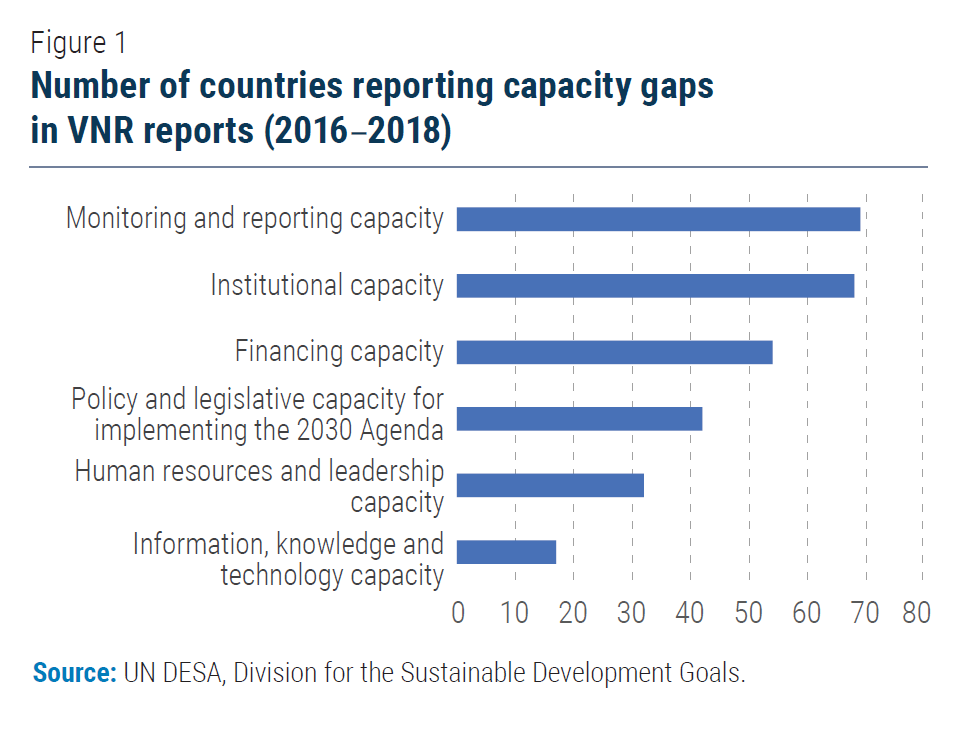 In other cases, administrations have developed training materials such as massive online open courses (MOOCs) on SDGs, which are now found in many countries, and organized training activities. For instance, the Legislative Assembly of Costa Rica has trained legislators and parliamentary staff on implementing the SDGs in legislative work. Teachers are a central target of capacity-building activities on the SDGs. Teachers’ capacities are built through the introduction of the Goals in the school and university curricula. An example in the municipality of São Paulo in Brazil is the training of teachers on the SDGs and the development of SDG Learning Guidelines (with the support of UNESCO) as part of a new curriculum aimed at promoting education for sustainable development.
In other cases, administrations have developed training materials such as massive online open courses (MOOCs) on SDGs, which are now found in many countries, and organized training activities. For instance, the Legislative Assembly of Costa Rica has trained legislators and parliamentary staff on implementing the SDGs in legislative work. Teachers are a central target of capacity-building activities on the SDGs. Teachers’ capacities are built through the introduction of the Goals in the school and university curricula. An example in the municipality of São Paulo in Brazil is the training of teachers on the SDGs and the development of SDG Learning Guidelines (with the support of UNESCO) as part of a new curriculum aimed at promoting education for sustainable development.
Is capacity-building for the SDGs effective?
Available data clearly reveals that an increasingly wide range of capacity-building products has become available since 2015, associated with a growing number of activities. Despite this blooming landscape, it is difficult to assess the general effectiveness and responsiveness of capacitybuilding activities to recipients’ needs. This is due to multiple reasons, including a relative scarcity of capacity gap assessments and limited reporting by governments on capacity-building activities received by public servants. In general, the extent to which ongoing capacitybuilding efforts are driven by country capacity needs and gaps is not clear, as comprehensive, government-wide capacity needs assessments have remained infrequent. Among the 24 countries examined in the report, few have conducted a comprehensive, government-wide assessment of critical capacities needed to deliver the SDGs. Some of the available assessments show, for example in Mongolia, institutional capacity bottlenecks at all levels of government as a major impediment to ensuring implementation and support of SDG monitoring and accountability. An assessment in Nepal reveals the lack of capacity to integrate the SDGs into planning, programming, budgeting, and implementation processes and strengthen monitoring and evaluation systems at national and subnational government levels. Voluntary national review (VNR) reports from 102 countries from 2016 to 2018 show that most Member States reported having gaps in monitoring and reporting capacity followed by institutional capacity (see Figure 1). As of 2020, capacity-building strategies and plans for SDG implementation at a whole-of-government level are rare in the research sample. An exception is Spain, which adopted a government-wide approach to strengthening the capacity of public servants for SDG implementation at the national level with measurable targets (including incorporating contents related to the 2030 Agenda in all public officials’ capacity-building plans). In contrast, many countries have incorporated SDG-related concerns into capacity-building strategies and plans at the sector or thematic level. Examples include national strategies to strengthen capacity across all elements of the national statistical system in countries like Rwanda, Mongolia, and the Philippines. In general, reporting on capacity-building activities within public administration in VNR reports and national policy documents has not been a consistently high priority of governments. Areas identified in the 2030 Agenda as needing capacity- building and support by the international community (e.g. SDGs, localization, strengthening of national statistical systems, SDG indicators, and policy integration) have received high attention from both national and international actors. The related activities have high visibility in public documents. This does not mean that other areas do not receive attention, but that reporting on them is seen as less relevant or less urgent. Research conducted for the report shows an unevenly lit landscape, which can only be described in an approximative way. Given the importance of securing adequate skills and capacity in the public sector for implementing the 2030 Agenda, strengthening the tracking, and reporting of related activities in all parts of public administration would be highly relevant. Recipients of capacity-building activities are often not well identified in publicly available sources. It is, for instance, difficult to assess to what extent capacity-building has equally benefitted male and female public servants. Similarly, there is hardly any evidence of evaluations of actions to enhance the capacity of civil servants, parliamentarians, and staff from other public institutions to implement the SDGs. Given the lessons of capacity-development efforts in past decades, it is important to understand the levels targeted by ongoing initiatives, from that of institutions and systems to that of individual staff and infrastructure, to that of skills and tools. It is also critical to know how successful the selected approaches are in promoting change at those different levels. A key question is whether training has addressed public servants’ and public administrations’ ability to reach the furthest behind. In sum, available information does not easily allow for a consolidated picture of how ongoing efforts address gaps at the level of individual countries. It appears that, at least in the initial years following the adoption of the 2030 Agenda, capacity-building efforts were largely driven by the supply side. The proliferation of interventions and products suggests that many initiatives are ad hoc, based on national circumstances rather than resulting from strategic coordination, either among international or national actors. Research suggests a very fragmented landscape, with capacity- building activities targeting different ministries, government agencies, and public institutions with little apparent coordination among them. While the breadth of scope of the 2030 Agenda and the number of actors operating in this field make fragmentation hard to avoid, increased transparency on the existing capacity-building activities may help to reduce duplication and reap opportunities for synergies. In addition, decreases in or reallocation of available resources during the COVID-19 pandemic may have resulted in lower priority being given to long-term capacitydevelopment efforts, including in support of SDG implementation. Constraints imposed by the pandemic on physical meetings, travel, and other resources have affected the delivery of capacity-building efforts, with a shift to digital delivery modes. At this stage, little is known about the changes in learning outcomes that may have occurred and their impacts on capacity in the public service.
Untapped potential for cross-fertilization of capacity-building initiatives?
As new capacity-building materials keep emerging, products initially developed in one country or by individual organizations have started to be disseminated, translated, and adapted to other countries. Prominent examples include SDG awareness-raising material, such as the SDG icons, basic SDG brochures, and guidelines produced by international networks and translated into different languages. On a similar note, issue-based international networks – e.g. Local 2030 – have constituted repositories of guidelines, training material, reports, and country examples, which provide useful points of departure for national capacity-building efforts. Notwithstanding differences in the capacity of national institutions to implement the SDGs, the needs of specific institutions (for instance, parliaments) and functions of government (for example, planning, monitoring), share many commonalities across countries. There seems to be untapped potential for cross-country sharing and fertilization in this regard. Providing more resources for the translation and adaptation of existing material, rather than privileging the development of new products, could in some cases provide efficient and effective solutions to addressing capacity gaps at the country level.
Conclusions
National governments, in collaboration with international organizations and other national actors, could consider some of the following measures to enhance the capacities of public servants to implement the 2030 Agenda:
• Conduct regular, government-wide capacity needs and gap assessments regarding national plans for SDG implementation by public institutions.
• Systematically collect disaggregated information on capacity-building for SDG implementation, monitoring, and evaluation in public institutions at all levels and make such information more accessible within and outside government.
• Conduct evaluations of the adequacy, impact, and effectiveness of capacity-building efforts for SDG implementation, monitoring, and evaluation – also considering lessons from the COVID-19 pandemic – and assess any need for adjustments.
• Enhance coordination and stimulate synergies among actors involved in the design and delivery of capacity-building products.
 Welcome to the United Nations
Welcome to the United Nations
